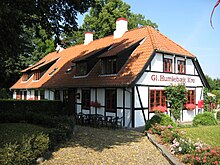User:Kobberholm/sandbox
Eating out[edit]

Eating out in restaurants can be a costly affair, with the average price running higher than that of the European average.[1] As a result of the New Nordic Cuisine trend, Danish restaurants are now firmly on the international gourmet map.
Restaurants[edit]
Denmark has many fine restaurants, not only in the larger cities, but also in the countryside. The kro (roughly equivalent to an inn, but held in higher social regard) provides lodging as well as meals and drinks. Especially the royally privileged lodges have a long and interesting history.[2] Danish cuisine continues to evolve and keep up with the times. It has become more health-conscious, and has drawn inspiration not only from the traditional French and Italian kitchens, but also from many other more exotic gastronomical sources. Increasingly, restaurants are turning to trends based on a combination of continental cooking and the growing interest in products from the local environment served in accordance with seasonal availability.[3]
Cafés[edit]
Another reasonable place to eat is at a café. These are plentiful, especially in the bigger cities, and usually offer soups, sandwiches, salads, cakes, pastries, and other light foods, in addition to the expected coffee, tea, beer and other beverages.
In the summertime, outdoor serving is an extremely popular option.

Fast food[edit]
In the big cities, and in shopping districts, there are many more reasonably priced eating places including several American fast food chains. The most common quick food restaurant is the "burger bar" or "grill bar" which typically features hamburgers, pizza, hot dogs and a wide variety of other fast food staples. These can be found in every town in the country, large or small. Other commonly found fast foods include Turkish and Middle East food specialties such as falafel, shish-kebab and spit-roasted meat (most often shawarma) with salad in pita bread, or wrapped in durum wheat based flatbread.[4]
Hot dog vans[edit]


Another common quick food alternative, the "original" fast food outlet in Denmark, is the pølsevogn (sausage wagon) food truck, where one can eat a variety of different sausages, including Denmark's very famous red sausages, røde pølser. These hot dog-like sausages are long (ca. 20 cm long), thin (about the diameter of an index finger) and bright red. They are traditionally served on a small, rectangular paper plate along with a side order of bread (similar to a hot dog bun, but without a slice in it), and a serving of both ketchup, Danish remoulade sauce, which is somewhat similar to American relish, and mustard. The sausage is hand held, dipped into the sauce and eaten. The bread is eaten alternately, also dipped into the sauce.[5]
When the sausage is served in a traditional hot dog bun, it is called a "hot dog". It is commonly served with remoulade, ketchup, mustard, onion (either raw or toasted, i.e. ristede) and thin sliced pickles on top. Ristede onions are similar in taste to French-fried onion rings. Another variety is the French hot dog (Fransk hotdog) which is a sausage stuffed into a special long roll. The roll has a hole in the end, in which the hot dog is slipped into, after the requested condiment has been squirted in (ketchup, mustard, different kinds of dressing). The simplest sausage wagons are portable and very temporary, but most are more permanent. They are typically a metal wagon with an open window to the street, and a counter where one can stand and eat the sausage. More advanced wagons may be built in and include limited seating, usually both inside and outside. Through the years the number of sausage wagons has dropped as competition from convenience stores, gas stations and kebab and pizza-places has increased.[5]
- ^ "Eurostat News Release: Consumer price levels in 2008 (104/2009)" (PDF). Eurostat Press Office. 6 July 2009. Retrieved 4 Sep 2010.
- ^ "Warm-welcome Inns", VisitDenmark. Retrieved 8 December 2011.
- ^ Cite error: The named reference
denmarkspecialwas invoked but never defined (see the help page). - ^ "Danish-food", Denmark-Getaway.com. Retrieved 8 December 2011.
- ^ a b Mylius Thomsen, Allan (2006). Café Fodkold - Eventyret om den danske pølsevogn. Copenhagen: Lindhardt & Ringhof. ISBN 87-90189-15-9.

